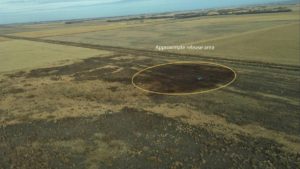
The crude oil spill from the Keystone Pipeline in South Dakota last November has turned out to be nearly twice as big as first reported. Around 407,000 gallons spilled onto farmland when the pipeline broke near Amherst in Marshall County on Nov. 16th. TransCanada had originally put the spill at 210,000 gallons but the new number would make the spill the seventh-largest onshore oil spill since 2010, according to the U.S. Department of Transportation.
TransCanada had shut down the 590,000 barrel-per-day pipeline, one of Canada’s main crude export routes linking Alberta’s oil fields to U.S. refineries, immediately following the spill. Repairs were made and TransCanada resumed using the pipeline 12 days after the leak. Immediately after the leak was reported South Dakota regulators said they could revoke TransCanada’s permit for the Keystone Pipeline if an investigation concludes that the company violated its terms. If that happens, the company would have to correct any issues—in the worst case, even replace part of the pipeline—before oil shipments could resume.
A preliminary report indicated that the pipeline might have been damaged during its’ construction in 2008, though the investigation is ongoing. The Pipeline and Hazardous Materials Safety Administration is expected to release its final report on the leak in the next few weeks. The federal agency has estimated that the leak cost TransCanada $9.57 million. The Keystone Pipeline carries oil more than 2,600 miles from Alberta, Canada, to Oklahoma and Illinois.
In February, TransCanada Corp. reported that the cleanup of the massive oil spill was halfway finished. TransCanada spokeswoman Robynn Tysver said work at the Amherst site has transitioned from excavation to remediation. She stated that all of the excavation work has been completed and most of the impacted soil has been removed. In late March, Tysver said the company had replaced the last of the topsoil and have seeded the impacted area.” The company also agreed to restore the roads used by trucks transporting equipment and soil.
A spill and activity report on the agency’s website shows that TransCanada has installed groundwater monitoring systems, which haven’t yet detected any contamination. The pipeline runs through both Dakotas and two other states and drew fierce resistance from the Standing Rock Sioux tribe in North Dakota, the tribe’s allies and environmentalists. Opposition to the pipeline sparked month’s long protests, with as many as 10,000 people participating during the peak of the demonstrations.
Read more

A total of 210,000 gallons of oil leaked Thursday from the Keystone Pipeline in South Dakota, the pipeline’s operator, TransCanada, said. Crews shut down the pipeline within minutes of discovering an irregularity and officials are investigating the cause of the leak, which occurred about three miles southeast of the town of Amherst. The spill has been controlled, the company said, with no further environmental impacts observed and no threat to public safety.
Brian Walsh, a spokesman for the state’s Department of Environment and Natural Resources said “ This is the largest Keystone oil spill to date in South Dakota. In April 2016, there was a 400-barrel release — or 16,800 gallons — with the majority of the oil cleanup completed in two months, Walsh said. About 5,000 barrels of oil spilled Thursday. “It is a below-ground pipeline, but some oil has surfaced above ground to the grass,” Walsh said. “It will be a few days until they can excavate and get in borings to see if there is groundwater contamination.” “There were no initial reports of the oil spill affecting waterways, water systems or wildlife” he said.
According to the South Dakota Department of Environment and Natural Resources’ website, this is the third pipeline spill in the state this year. Another 84 gallons of crude oil leaked from the controversial Dakota Access Pipeline in Spink County in April. That pipeline, which runs through both Dakotas and two other states, drew fierce resistance from the Standing Rock Sioux tribe in North Dakota, the tribe’s allies and environmentalists.
The leak comes just days before Nebraska officials announce a decision on whether the proposed Keystone XL Pipeline, a sister project, can move forward. The Keystone Pipeline system stretches more than 2,600 miles, from Hardisty, Alberta, east into Manitoba and then south to Texas, according to TransCanada. The pipeline transports crude oil from Canada. The sections of pipeline affected stretch from Hardisty to Cushing, Oklahoma, and to Wood River, Illinois.
The proposed Keystone XL Pipeline, which would stretch from Hardisty to Steele City, Nebraska, would complete the proposed system by cutting through Montana and South Dakota. TransCanada said it was working with state and federal agencies. “The safety of the public and environment are our top priorities and we will continue to provide updates as they become available,” the company said. Environmental activist group Greenpeace said the spill shows the new pipeline in Nebraska should not be approved.
In March, the Trump administration officially issued a permit that approved construction of the Keystone XL Pipeline. The approval followed years of intense debate over the pipeline amid hefty opposition from environmental groups, who argued the pipeline supports the extraction of crude oil from oil sands, which pumps about 17% more greenhouse gases than standard crude oil extraction. Tar sands oil is also much thicker and stickier than traditional oil, significantly complicating cleanup efforts. Since it’s thicker, it needs to be combined with other hazardous materials to allow it to be transported in pipelines.
Read more




